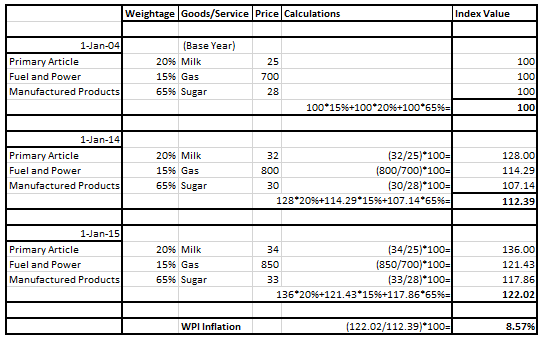Calculating Inflation and its relation with the Currency
It had
been a month since I joined IIM Kashipur to pursue my MBA and I was loving this
place already. Hostel life was a completely new experience for me. The fact
that tourist attractions like Jim Corbett Park, hill station of Nainital are an
hour away from the institute was fascinating. This was the first time I had
moved out of Mumbai, away from my family, but technologies such as Skype helped
me to break the geographical barriers to great extent. It was time for me to keep my promise on the
deal that I had struck with Apurva and have the weekly Skype session to answer
her questions. After the discussion about my life at IIM Kashipur, we started
the discussion where we had left.
“Before
you tell me the relation between the currency and the inflation, I have been
wondering all this while as to how RBI calculates the inflation and concludes
whether it is high or low ?”,asked Apurva.
“RBI
uses an Index called as Wholesale Price Index (WPI) to calculate inflation”, I
started explaining her. It is an index build with the prices the wholesalers
have to pay to the manufacturer. This index is an indicative figure whose value
can be compared with previous time period such as previous month or previous
year. In WPI there are more than 650 goods and commodities whose wholesale price is
tracked. These commodities are divided in three main categories which are
1.
Primary Articles 2. Fuel and Power 3.
Manufactured Products.
These
three categories are given weight as per their influence in day to day life
of a common Indian Man. Primary Articles are given 20% weight while Fuel and Power
are given 15% and Manufactured Products are given 65% weight. Each of these
categories have many items with the weight distributed among the category. And
as with every index there is a base year whose value is considered to be 100
and new value of index would be calculated based on the base year value. For
WPI year 2004 is considered to be base year with the value of 100. Let me
explain this with the help of an example. For simplicity, assume there are only
three items that existed: Milk, Oil and Sugar.
 |
| WPI_Calculation_Simplified |
So as
per the calculation the WPI inflation is 8.57%. The WPI inflation number is
available weekly every Thursday with two weeks of delay. WPI is the main index
which is followed by RBI as to decide whether the inflation is in control or
not. Apart from WPI, RBI also looks for a Consumer Price Index (CPI) which is a
price index calculated based on the prices which end consumers pay to the
retailers. This index indicates actual inflation in the hands of consumer and
not just for the wholesalers.
“RBI
would want WPI inflation to be 0% or even negative, right?” asked curious
Apurva. “Not really”, I started explaining her. RBI would want this to be
around 3-4% ideally on the consistent basis. RBI also needs to keep a check on
the CPI along with WPI. If inflation is 0% then the total output would not grow
and working population would not get their promotions and salary hike. We
cannot allow the inflation to go beyond a particular bracket because the salary
hikes are not consistent for all, i.e. Income is not uniformly distributed
while the increased expenditure is! The rich people of the society can afford
the inflation but poor people will not be able to afford it as their income
levels have not increased compare to increase in the inflation.
“Now
that I understand how inflation is calculated can you please tell why the
change in the currency would lead to inflation? I mean, why would change in the
currency value would increase the price of the goods and commodities?
“It
would be unfair to say that the price of the commodities and goods change if
there is a change in the currency but it certainly impacts the inflation”. Let us take an example,Suppose on 1st of
January 2014, 1$= ₹50. Suppose you want to order an iPhone 6 plus from USA
since it has yet not been launched in India.Assume that an iPhone 6 plus costs $1000. The
US retailer selling the iPhone to you would prefer the payment in $ as USA has
currency of $. So you have to pay ₹ 50000
typically to a Bank or an institution which is into the currency exchange
business and buy $1000 and buy the iPhone 6 plus. 2 days after the purchase on
3rd of January 2014, you show this iPhone to your best friend and
now she also wants a similar phone but on 3rd of Jan 1$= ₹ 60. The iPhone
price is still $1000 but now to buy $1000 you have to give ₹ 60000. Even though
the price of iPhone stayed $1000 you still experienced inflation. This is
because the purchasing power of Indian Currency has reduced. That is why when the 1$ value changes from ₹ 50 to ₹ 60 we say that Indian Rupees has depreciated
as the currency cannot buy as much as it could earlier and we say that $ has
appreciated because it take more Rupees to purchase similar amount of $.
“I now
understand the how inflation is calculated and relationship between the
currency and inflation but why does the value of 1$ change?” asked Apurva.
"There are many factors that govern the movement of the currency, let us
discuss them next time,when we have the Skype session”, I told her. It was already
11.30 in night but like all others studying in IIM, day had just begun, I
thought.


